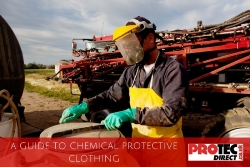Personal protective clothing (PPE) has many obvious physical benefits. Hard hats on site can prevent blunt head trauma from falling objects and collision, Hi-vis clothing makes you less vulnerable to accidents and no right-thinking workman would leave the house without a pair of steel toe-capped boots adorning their feet.
However, when working around chemicals, the threat is very different but equally as serious – if not more so. There are a huge array of dangerous substances that are used in construction, manufacturing and numerous other industries. When working with hazardous chemicals, it is essential you are adequately protected against spillages, contact with skin and clothes, and inhalation. Insufficient chemical PPE can result in injury, chronic health conditions and even death.
Read our chemical protective clothing guide to learn about what the risks are and what chemical PPE you should be wearing to stay protected.
What you need to know
Chemical PPE is in no way a substitute for inadequate control methods. The first line of defence is always prevention following a proper chemical risk assessment.
It’s also worth remembering that timescale is very important. No glove material can remain impervious to specific chemicals forever as chemical processes and reactions will wear away PPE over time, so it’s important that you look after it, clean it adequately, and replace when necessary.
Specific safety information regarding lifespan and usage should be found on the PPE products themselves, and if it’s not, you should contact the manufacturer.
Understanding permeation rates and degradation
These are important terms for understanding PPE safety. The permeation rate is the speed at which a substance can move through a material, expressed in units such as milligrams per square metre per second. The higher the rate, the faster the process and more at risk you are. Degradation refers to the physical deterioration of the material due to contact with chemicals. In the worst case, extreme degradation results in materials completely dissolving.
Choosing the right materials
As you may be able to tell from the above, knowing how to choose the correct PPE materials is the core of good chemical protection. You should ideally understand the concepts and uses of permeation rates and apply this to manufacturers’ instructions. This should happen in the risk assessment stage and should bear in mind factors such as contact period, decontamination procedures and cleaning.
Depending on the risk factors involved, materials such as heavy-duty rubber, neoprene, PTFE and butyl rubber should be used to protect your skin.
What chemical protective clothing to wear
Skin protection
Because chemicals can be corrosive, irritating, or otherwise dangerous, protective your skin should be a priority consideration. Boilersuits or coveralls are the best bet for proper protection, leaving no skin uncovered.
Eye and face protection
Of course, adequate safety goggles (potentially with full seal) and breathing apparatus should also be used if there is inhalation or eye damage risk. Chemicals have a tendency to splash so your eyes are vulnerable without goggles and inhalation of some chemicals can be extremely dangerous.
Footwear
Spillages are another key risk when working with chemicals, so making sure that you have adequate protective footwear is essential. Common footwear materials like leather will be penetrated easily by some corrosive chemicals so choose chemical resistant boots made from a suitable material.
Hand protection
As chemicals are handled manually, gloves are probably the most important chemical PPE. There is a range of different types of safety gloves that can be used, and which ones you opt for should depend on what chemicals you’re working with.
The importance of training
Knowing how to correctly use and put on chemical PPE involves the correct training. This will also help you to understand the sometimes complex assessments that are needed to choose the right materials. All PPE used should be properly enforced and monitored, with equipment regularly inspected for signs of damage and wear.
It is just as important to stay safe when working with any kind of chemicals as it is when working on site or around heavy machinery. Good chemical PPE practice can save lives and reduce the risk of serious injury.





Leave a comment